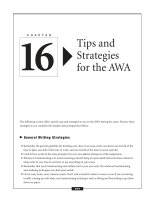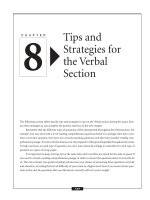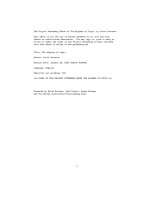100 Tips and Techniques for Getting the Job Done Right by Tom Kendrick_6 doc
Bạn đang xem bản rút gọn của tài liệu. Xem và tải ngay bản đầy đủ của tài liệu tại đây (569.56 KB, 9 trang )
storage magazine. e latest tool presetting machines
equipped with a full suite of tool management features
and functions, can play a big role in improving shop:
productivity/component quality, tool life, inventory
control, whilst minimising down-time, reducing com-
ponent cycle times and part scrappage.
Mounting and Adjusting Milling Cutters
Possibly the most crucial cutter body to correctly
mount and adjust, for the individual cutting inserts,
is that of a side-and-face cutter (Fig. 138). e reason
why it is important to set the cutter assembly up cor-
rectly, is that invariably the width of the slot in the ma-
chined workpiece is identical to that of the respective
rotating face widths of the cutting edges. Moreover,
whole cutter assembly must ‘run true’ as it rotates on its
arbor
39
– with no discernible ‘wobble’ – as this eective
‘wobbling’ will inuence the machined slot geometry.
At its most extreme, some of these special-purpose
slotting cutters can be >2 tonnes in weight and larger
than 1.5 m in diameter, having segmented cartridges
that are precisely and accurately tted onto the periph-
ery of the cutter body. As a general ‘rule of thumb’ ,
most of these types of slotting cutters are used to ma-
chine component features to a depth of four times
their slot width
40
. If a deeper slot is required, then the
cutter has to be ‘optimised’ in some way. Perhaps by
using a smaller width cutter than that required for the
component’s slot width and, if possible, cutting each
slot face separately and eventually taking it to the de-
sired width/depth – arbor interference permitting.
Mounting cutting inserts in the case of the stag-
gered-toothed side-and-face cutter body shown in Fig.
138, is relatively straight forward, due to the lateral
adjustment available by the splined cartridge seatings.
Here, it is important to ensure that the insert seat is
thoroughly cleaned prior to commencing tment.
Moreover, ensuring that the contact against the bot-
39 ‘Arbor’ , is the workshop term used for the extension from the
machine tool’s spindle that the slotting-type cutter is located
and driven from. It can be cantilevered – termed a ‘stub-ar-
bor’ , or supported at its free-end, by an arbor-support – nor-
mally tted with adjustable and suitable matched-bearing di-
ameters.
40 When full slotting, using a side-and-face milling cutter at 40%
of the maximum radial cutting depth, a typical feed per tooth
would be around 0.25 mm tooth
–1
.
tom face of the seat occurs, prior to tightening the set
screw – normally to a nal torque value of 5 Nm (i.e.
illustrated in Fig. 138b). Each set screw should be lu-
bricated with the recommended lubricant before re-
use. In order to ensure that each cutting insert runs
true, the slotting cutter, or face mill assembly, should
be correctly mounted – in the former case, onto the ar-
bor, the latter into the correct spindle nose taper – be-
ing held on a suitable presetting machine. e whole
assembly is then rotated to ensure that each cutting in-
sert is both radially and axially positioned, thereby en-
suring that no edges ‘stand-proud’ of each other and at
the same time conrming that no discernible ‘wobble’
in the rotating assembly occurs (i.e see the deep-slot-
ting cutter, held in a stub arbor with support, allowing
the whole tooling assembly to be rotated and each cut-
ting insert to be inspected/measured, in Fig. 139).
Although cutter keyways are not strictly-speaking a
mounting problem, the subject does need to addressed,
as if the cutter’s diameter and its associated driving
keys are not considered, this will limit the overall mill-
ing performance of the cutter. With most slotting, and
side-and-face cutters tted to arbors, they normally
require a keyway/key for rotational driving purposes
for the whole cutter assembly. Usually cutters that
are <φ125 mm with insert sizes ranging between 6 to
8 mm
, then one key will suce, but cutters >φ140 mm
with insert sizes of between 11 to 14 mm, they would
frequently need two keyways
41
.
Cutter diameter and driving key limitations, are de-
termined by the cutter’s bore and its connected key-
way, together with the D
OC
being limited by several
factors: the arbor OD, its mechanical strength, plus
any deformation of the driving key(s). For vertical
slotting applications, mounting the cutter on an large
diameter arbor with the minimum of overhang is de-
sirable. If the feed per tooth can be reduced – assum-
ing component cycle-times will allow – then this will
reduce the tendency of key deformation during mill-
ing. Milling calculations and key strength, can be ob-
tained from the following expressions and are valid for
new cutting inserts:
41 Keyway positioning for two keys – is usually given by the dis-
tance between them as: 180° minus half the peripheral pitch
of adjacent cutting inserts – as shown in the diagrammatic
sketch in Fig. 138a.
Chapter
Figure 138. The correct mounting
and setting of a cutting inserts in a
staggered-toothed side-and-face cutter
body. [Courtesy of Sandvik Coromant]
.
Torque (T) = P [kW]/n [rpm] × 60,000/2π [Nm]
Force (F) = T/d [mm] × 1,000 [N]
Shear [keyway] stress (τ) = F/area = F/A × E [N mm
–2
].
NB
As the cutting inserts wear, the above values will
increase by approximately 30%, therefore, it is usual
to add a ‘safety factor’ to the key(s) material shear
strength, by multiplying this value by 1.5.
Modular Tooling and Tool Management
Figure 139. Cutting inserts for large diameter cutters require pre-setting to mini-
mise any run-out. [Courtesy of Starrag Machine Tool Co. and Sandvik Coromant]
.
Chapter
If special-purpose applications are required, such as
when form milling the ubiquitous ‘Vee-and-Flat’ con-
guration for an conventional engine-/centre-lathe
bed, ‘gangs’
42
of: side-and-face, angled- and helical-cut-
ters are deployed to form and generate these slideways.
Here, it is important to ensure that when presetting
the cutters on the tool presetter, that the whole cut-
ter assembly is held in the exact manner that they will
be utilised when ‘gang-milling’. is ‘gang-milling’ set-
up, allows their dimensions and forms to be inspected/
measured, while slowly rotating the whole assembly. If
two ‘helical cutters’
43
are utilised in a ‘gang-milling’ op-
eration, then their helices should be of the same pitch,
but of dierent ‘hands’ (i.e. le-ward and right-ward
respectively), as this arrangement will balance-out any
end-thrust due to opposite cutter helices.
Setting up ‘Long-edge milling cutters’ – these are
sometimes termed ‘Porcupine cutters’ (i.e. see Fig.
124 – centre), which are normally required for the
heavier and longer cutting applications, is quite a com-
plex presetting process. As the individual cutting in-
serts must be slowly rotated to ensure that axial and ra-
dial run-out values are kept to a minimum. Otherwise
those inserts ‘standing-proud’ of the remainder will
suer from greater wear rates, thereby prematurely re-
ducing the cutter’s eective life quite signicantly while
milling an unwanted step into the machined sidewall.
On standard face mills, ‘face run-out’ can be as high
as >50 µm, so when close tolerances and good milled
surface texture is mandatory, then extreme care must
42 ‘Gang-milling’ , is a complex forming process utilising two,
or more milling cutters adjacent to one another. So, a side-
and-face cutter, located directly together with a helical cutter,
represents a ‘gang’ in its simplest form. is ‘gang’ of cutters, is
normally permanently mounted together for re-grinding and
tool presetting – this is assuming that the cutting edges are
not made-up from a series of strategically-positions indexable
inserts (see Fig. 76).
NB ‘Straddle milling’ , should not be confused with ‘gang-
milling’ , as here, it is normal to use two side-and-face cutters
with spacing collars between them – of a specic and known
dimensional size. erefore, the cutters ‘straddle’ the part –
hence its name – while they machine two faces at the required
distance apart in one pass along the workpiece.
43 ‘Helical cutters’ , are sometimes known as ‘Slab-mills’ , hav-
ing either a le-, or right-hand helix, which ensures that the
length of cut and its shearing mechanism are reduced by a
‘quick-helix’ , which is necessary for the milling of more duc-
tile materials.
be taken when presetting such tooling assemblies. In
order to assist the presetting of such tooling on some
face mills, ‘barrel screws’ allow ne adjustment to the
cutting insert (Fig. 140a). Such ‘barrel screw’ designs
are quite simply-designed, but surprising eective in
both adjusting and retaining the cutting inserts, the
following remarks explain how they are designed and
their method of operation. ‘Barrel screws’ (Fig. 140a),
are hardened to resist deformation and have a black-
oxide nish to minimise corrosion. To prevent them
from shiing during a face milling operation, a nylon
pellet is embedded in the thread of the ‘barrel screw’.
Right-hand cutting inserts use le-hand ‘barrel screws’
and vice versa, as this counter-acting rotation keeps the
insert locked rmly in its pocket. e mating surface
of a ‘barrel screw’ is reamed produce a minimum con-
tact of 120° occurs, which ensures accuracy and preci-
sion, while minimising wear. e ‘barrel screw’ hole is
o-set toward the reamed surface, to provide positive
contact with the mating surface throughout the range
of adjustment of this screw. It should be noted, that
these ‘barrel screws’ cannot adjust the eective ‘gauge-
length’ of the tooling, as the amount of adjustment is
limited by the position of the cutting insert’s clamping
screw.
e face-milling cutting inserts shown in Fig. 140a
are tangentially-mounted, oering considerable sup-
port and additional strength to the cutting edge. When
presetting the face mill’s cutting edges when the cut-
ter body is equipped with ‘barrel screws’ , the following
procedure should be adopted:
•
To adjust the insert outward – leave the cutting in-
sert tight and simply turn the ‘barrel screw’ to move
the insert to the desired setting.
NB Adjustment to the cutting insert’s position,
should only be made in one direction only.
•
To adjust the insert inward – loosen both the cut-
ting insert and ‘barrel screw’ , push the insert in
-
ward, then tighten the insert’s screw and adjust out
again to the desired position.
In Fig. 140b, the simple ‘ow-chart’ highlights why it is
important to keep any face milling cutter insert’s run-
out to a minimum. If the run-out of both the minor
and peripheral cutting edges is large, then this can
create several undesirable problems for the tooling as-
sembly, including:
•
Poor surface nish – if a cutting insert ‘stands-
proud’ of the others in the face mill, then it will cut
Modular Tooling and Tool Management
Figure 140. Cutting inserts need to be precisely and accurately seated in their respective pockets of the cutter body, to eliminate
potential run-out
.
Chapter
in a similar fashion to that of a y-cutter, creating a
periodically scored surface – aer each cutter revo-
lution – degenerating the milled surface texture,
•
Chipping due to vibration – as all of the inserts are
not set the same, then the most prominent one will
take the largest cuts on both the minor and periph-
eral cutting edges, causing shock loading as the cut
is engaged, thereby increasing cutter vibration and
potential thermal eects
44
creating the likelihood of
chipping here on the most exposed cutting inserts,
•
Rapid growth of wear – because of a prominently
set and poorly positioned cutting insert in relation
to the others in the cutter body, it will absorb the
greatest cutting loads, which will lead to shortened
tool life, this being exacerbated by pronounced vi-
brational tendencies, resulting from unbalanced
cutting forces and torque.
NB All of these factors will contribute to a short-
ened cutter life.
Conversely, if the face milling cutter’s insert run-out is
small, then a good surface nish and stable and predict-
able tool life will result.
Mounting and Adjusting Single-Blade Reamers
e cutting head of a single-blade reamer was previ-
ously illustrated in Fig. 74a. e replaceable blade
is positioned longitudinally by a blade end stop and
44 ‘ermal fatigue’ , can be present when cutting is interrupted
– as is the case for milling with a prominently exposed ce-
mented carbide cutting insert. Numerous cracks are oen ob-
served at 90° to the cutting edge and are oen termed: ‘Comb-
cracks’ – due to their visual appearance to that of a typical
hair-comb. ese cracks, are the result of alternating expan-
sion and contraction of the surface layers as the cutting edge
is heated during cutting, then cooled by conduction into its
body during intervals between cuts. is very fast alternating
heating and cooling cycle, develops the cracks normally from
the hottest region of the rake face – this being some distance
from the cutting edge, which tends to spread across this edge
and down the insert’s ank face. Once these cracks become
quite numerous, they can join up and promote partial tool
edging to break away – creating cutting edge chipping.
NB Today, many cemented carbide tooling manufacturers
use structures and compositions that are less sensitive to ther-
mal fatigue, moreover, coatings also play a signicant role in
reducing thermal fatigue eects, when milling.
diametrically adjusted using the front and rear adjust-
ing screws. e blade is micro-adjustable over a lim-
ited range of radial movement and can be preset in
a special-purpose setting xture (Fig. 141a and c), to
ream the desired diameter that the tool can then con-
sistently produce. is reaming blade normally has a
back taper of: between 0.01 to 0.02 mm over a linear
distance of between 10 to 25 mm, respectively – when
positioned in the pre-setting xture (Fig. 141b shows a
three-guide pad designed single-blade reamer). A fea-
ture of the blade’s adjustment, is that it can be reset to
compensate for any subsequent blade wear. A clamp,
plus two clamping screws securely holds the blade in
place, with the wedge-type clamp providing support
along the entire blade length (Fig 74a). In the case
of the single-bladed reamer design illustrated in Fig.
74a, the blade is located and positioned in the ream-
ing head at an 12° positive rake angle. For this type of
reamer design, additional standard blades can be t-
ted, oering both 6° and 0° rake angles.
Taper reaming setting can be achieved by mounting
the taper reamer (i.e a taper reamer is shown ream-
ing a component feature in Fig 73b), into the spe-
cial-purpose setting xture (Fig. 141c). At least two
dial-, or electronic-indicators are positioned along the
blade’s length, then adjusted so that a very light pres-
sure is applied to the cutting edge of the blade – to
prevent it from inadvertently chipping. With the
blade ‘semi-clamped’ , adjustment is made so that its
is parallel along its length – relative to the tapered
guide pads. Once the blade has been ‘fully clamped’ ,
adjustment occurs to position it higher than its guide
pads’ diameter, by between 10 to 20 µm – all along the
blade’s length, which achieves an accurate setting, but
this setting will depend on both the workpiece mate-
rial and the prevailing machining conditions
45
.
.. Tool Store and its Presetting
Facility – a Typical System
In the worst case scenario, for many of the ‘old-style’
traditional workshops, the tools are as oen as not
45 Taper reamers – typical machining details: Cutting speed 4 to
20 m min
–1
(Stainless steel 2 to 6 m min
–1
), Feed 0.2 to 0.8 mm
rev
–1
, Machining allowance 0.2 mm and up to 0.5 mm – for
large taper reamers, plus Coolant soluble oil @ 10% dilution.
Modular Tooling and Tool Management
Figure 141. Presetting equipment and ‘guidelines’ for the setting of single-bladed reamers.
Chapter
treated with almost contempt, until they are required
for a repeat order, or utilised for a new machining op-
eration. Here, when the tools are not in use, problems
arise because of the following:
•
Wasted and poorly utilised space – tools are kept
either simply ‘oating around’ in an ‘ad hoc’ sys-
tem, or are just sitting on top of each other – dam-
aging the precision-ground tooling surfaces – while
being kept in the open,
•
Time is lost looking for tools – due to the lack of any
form of tool management, tools must be looked for
located, then assembled – under less than ‘ideal con-
ditions’ – so the minimum of tool control occurs,
•
Lack of eciency – as a result, more eort is re-
quired by personnel who must try to nd tools,
changing front- and back-ends to suit the selected
machine tool for the production run causing lead-
times to lengthen.
Considering that up to 10% of the machine tool cost
is tied-up in the purchase of tooling, then tools need
to be looked aer with some degree of care and atten-
tion. An area adjacent to the workshop, should be set
aside for the purposes of storing tools and associated
equipment in purpose-built tooling cabinets (Fig. 142)
and form a basis for tool presetting activities. ere
are several advantages in utilising telescoping drawer
cabinets for tool storage (Fig. 137a and b), these in-
clude:
•
Increased tool storage density – allowing the
drawer space to be completely eciently lled-up
in the minimum of space,
•
All tooling is kept under cover – thereby avoiding
tool damage, while keeping tools dust and debris-
free,
•
All tools and ‘associated paraphernalia’ are read-
ily to hand – tooling drawers can be completely
open-up, so that the contents are both easy to see
and to arrange,
•
Tooling components t into their respective
places – the drawers appropriately sectioned, to to-
tally enclose the tools and their component parts,
making it impossible for them to drop out and be
damaged,
•
An organised and practical tool management sys-
tem is achieved – within the tool store and pre-
setting facility. erefore, all of the tooling com-
ponents can be classied and categorised in the
respective drawers – with every tooling part clearly
seen.
As a result of this ecient tooling component lay-
out and tool-kitting facility, consumable tools can be
‘tracked’ within the tool store, but when these consum-
ables leave the store vicinity (Fig. 142c), they are to all
intents and purposes ‘scrapped’ as far as the tool stores
are concerned. Returnable tools destined for eventual
re-use can be ‘tracked’ around the machine shop by
a number of tool-identication means (i.e as seen in
Figs. 116 and 117 – using ‘tagged tools‘), or at the most
basic of identication levels, by judicious labelling,
or bar-coding of tools, with feed-back of information
to the tool stores. Oen, for the most frequently used
tools, they are assembled into a composite forms, then
issued as ‘grouped-tools’ in the form of kits for a spe-
cic job (i.e see Fig. 142c).
Sometimes, tools are individually issued to ma-
chine tool setters/operators and are not assembled
into ‘kits’ , under such circumstances, the stores will
keep a record to show: to whom they were issued, the
machine tool on which they will be used, the num-
ber and identication of these tools, together with the
date of issue.
A major benet of creating an area set-aside close
to the machine tools for dedicated tool management,
is that tool kits can be made-up ahead of the time –
this being dictated by master schedule, so that they are
ready just-in-time before any machining commences.
A result of this timely tooling strategy, the lead times
46
are reduced, which is of prime importance to a com-
pany in a competitive fast-developing market.
Oen, it is the case that all tooling is assembled in
the tool stores /preparation facility (Fig. 142b). is
advanced preparation means that metrology-based
46 ‘Lead times’ , refer to the time taken before manufacture of
the part, or prior to a production run beginning. ese ‘times’
are dependent upon a range of interrelated factors, such as:
component stock quantities and their availability, the machine
tools that are available, plus ‘line-balance’* factors, etc.
*‘Line of balance’ (LOB), refers to a technique which permits
the calculation of the quantities of the particular activities, or
components which must have been completed by a particular
intermediate date, in order that some nal delivery schedule
might be satised. erefore, in this instance, it can be con-
sidered as a machine tool scheduling and a control technique.
In most of the LOB activities undertaken concerning machine
tools, plant utilisation levels are paramount and if possible, a
smooth and consistent LOB across all of the production ma-
chines is desirable – for both high eciency and consistent
work-throughput.
Modular Tooling and Tool Management
supplies such as ‘limit gauges’
47
, together with jigs and
xtures , are also the responsibility of the tool stores
personnel, being despatched with the tool kits for a
particular production run. When this is the case, to-
tal packages are issued, containing: cutting-tool and
work-holding kits, plus the limit gauges necessary for
metrological checking/inspection. A tool store and
prepartion facility with responsibility for all of these
tooling-related aspects, becomes a ‘focal point’ for
the machine shop for all matters relating to tooling,
whether they are for breaking-down of previously used
kits, calibration of gauges, or even purchase require-
ments for the latest tool available. Specialist personnel
in the tool stores/preparation facility, have consider-
able responsibility in servicing tooling for the overall
manufacturing resources on these machine tools and
as a result, will have amassed a large working-know-
ledge of the production tooling requirements, so their
opinions should be sought prior to any purchasing de-
cisions on new tooling.
.. Computerised-Tool
Management – a Practical Case
for ‘Stand-alone’ Machine Tools
If one considers the tooling requirement for a stand-
alone machining centre, then today the market de-
47 ‘Limit gauges’ , are based upon the stated International Stan-
dards agreed for ‘Limits and Fits’ for component toleranc-
ing. e use of limit gauges, is a form of ‘attribute sampling’*
where no attempt is made to determine the size of the work-
piece toleranced feature, but they are simply utilised to estab-
lish whether the component’s critical dimension is within the
specied limits of size, or not. In practice, a component that has
hole that has simply been drilled and reamed, might require a
double-ended plug gauge, with one ‘Go’ end of the plug gauge
being of full form and checking the maximum material con-
dition and as many dimensions as possible, with the ‘Not go’
end checking the minimum material condition and only one
dimension – which as its name implies, this latter end should
not go into the reamed hole. is limit gauging technique ful-
ls ‘Taylor’s eory of Gauging’.
*‘Attribute sampling’ techniques, are a means of sampling im-
perfections that are not in the strictest sense, measurable quan-
tities. For example, a mirror-surface that has been produced,
might be scratch-free, or may have other blemish marks, these
factors might be cause for its rejection. Hence, ‘attribute sam-
pling’ can be considered as a two-way classication system for
either acceptance, or rejection of the workpiece.
mands for its manufactured products has become
much more diversied, with the number and multiplic-
ity of tools required having also increased. As has been
shown previously in this chapter in the preparation for
workpiece machining, conrmation that all the tool-
ing – including spares (i.e. ‘Sister-tooling’ – see Foot-
note 1 in this chapter), must be loaded into the tool
magazine. A computerised-tool management system
(Fig. 143a), eliminates the possibility of mistakenly se-
lecting the wrong tool and exacerbating the situation
of placing it in the incorrect tooling pocket in the tool
magazine. With these ‘tagged tools’ (Fig. 143d) having
non-contacting read/write embedded microchips in
say, the pull-stud region of the assembled tool – allow-
ing coolant-through-spindle applications. e follow-
ing tooling data can be automatically registered into
the CNC memory (Fig. 143b), such as tool: number
and its ID number; name and the nominal diameter;
length, plus its ‘working-diameter’; thrust and power
coecients; interference data, with ‘large diameter’
tool data – if required; life accumulated/actual usage
time, wear and breakage ags.
Many quite complex and sophisticated computer-
ised-tool management systems exist, but essentially
the practical system depicted in Fig. 143, can be use-
fully applied to a machining centre in an ecient pro-
duction environment. Here, the system comprises of
three modules, these are:
•
Tool module – this being the smallest component
of the tool management system, where the tooling
data is both read/written at the machine magazine
tool loading/unloading position (Fig. 143c). e
tool data is automatically registered in the CNC
memory at the push of a button, with this tooling-
related data being continuously updated – as ma-
chining continues,
•
Tool Management module – once this is combined
with the ‘tool module’ (above), then tool manage-
ment is conducted on a much larger scale, allowing
not only all of the previous tooling data to be moni-
tored and controlled, but additional information on
the: toolholder’s bill of materials, insert inventory,
and its location, together with a graphic tooling
display of its build-up and information regarding
the correct procedure to ensure fast and error-free
tool measurement on the presetting machine (Fig.
143a),
•
Tool transportation module – consists of a tool
transporter robot having high positional accuracy
(i.e. not shown), which automatically transports
Chapter









